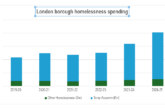We need an integrated housing policy that brings together both brownfield and greenfield housing development to help solve the housing crisis, says Lawrence Turner, Director of Boyer (part of Leaders Romans Group), commenting on the Secretary of State for Levelling Up, Housing and Communities Michael Gove’s speech on increasing housebuilding.
Michael Gove’s announcement will make it easier to convert retail premises and agricultural building into homes and relax Permitted Development rules for homeowners to convert loft spaces and renovate buildings — building on the Government’s ‘Brownfield First’ policy announced in February this year. The policy announcement is also expected to include creating Development Corporations that would have CPO powers to directly acquire land and build homes.
Regrettably, the current policy announcement falls significantly short of addressing the UK’s housing crisis. Offering a complete solution demands a balanced strategy, encompassing both brownfield and greenfield development, and a proper review of the Green Belt. Unfortunately, the present government announcements sidestep any commitment to development on greenfield land. Prioritising brownfield land is nothing new.
Governments have always prioritised the development of brownfield land — land that has been previously used for industry, commerce, or other urban uses, and is now derelict, under-utilised or contaminated due to its former uses. These areas always have presented an excellent opportunity for re-development, revitalising towns and cities, and providing new homes. However, the challenge for Mr. Gove’s policy announcement is twofold:
- The main constraint with brownfield land lies in implementation. Key challenges include securing funding for comprehensive site clean-ups, streamlining complex planning processes, and ensuring development remains viable while still delivering enough affordable homes. The introduction of development corporations will go some way to addressing these issues, but development corporations take some time to set up; are often perceived as undemocratic by local communities, generate significant opposition. Furthermore Compulsory Purchase is a very complicated and protracted process.
- There is simply not enough brownfield land to deliver the number of new homes that we need. The Government’s pledge to deliver 300,000 homes a year has not been met, and only this month the Levelling Up, Housing and Communities Select Committee a report to say this figure would be “impossible to achieve” by the mid-2020s.
This is correct, Britain does need more homes in the right places. However, we also need to make sure we build enough homes too. Prioritising new homes on brownfield land is the correct approach, but this strategy needs to be delivered alongside the delivery of new communities on greenfield land close to where people live and work and near to transport hubs. Often the careful release of Green Belt land in the most sustainable locations can provide significant benefits to local communities:
- Increasing the supply of new market and affordable homes, providing more choice for families to get on the housing market in the towns or villages where they grew up
- Delivering supporting community infrastructure and investing in the local economy
- Allowing opportunities for the creation of well-designed beautiful places. The delivery of new communities allows for long-term investment in a local area and through good placemaking can help re-green our towns and cities.
In conclusion, we need an integrated housing policy that brings together both brownfield and greenfield housing development as a solution to the UK’s housing crisis. Such an approach would increase the supply and choice of housing, promoting economic growth, and enabling the construction of well-planned and sustainable communities.










